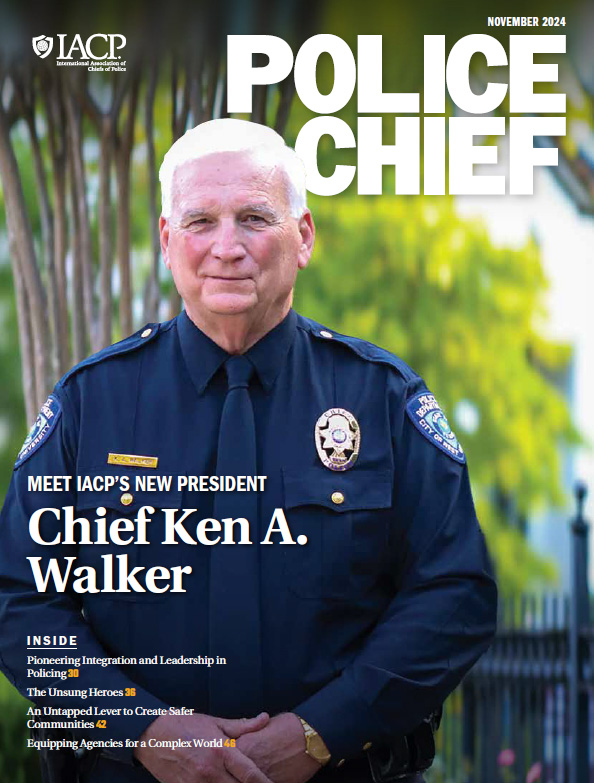If it’s predictable, it’s preventable.—Gordon Graham1
Every law enforcement organization has established policies and procedures that all employees are required to follow. In today’s world, there is often a written or otherwise formal acknowledgement of those policies required of all employees. The acknowledgement ensures the organization has recourse when the employee fails to follow the outlined policies and procedures, which often leads to progressive discipline up to and including termination.2 Even with policies and procedures in place, police organizations still have employees who violate policy. There is a myriad of reasons people violate the rules of an organization. Regardless of whether the violation is a result of ignorance, bad policy, or just bad behavior, the need for alignment still exists.
The standard solution to policy and procedure violations has been corrective action—a verbal or written warning, suspension, or termination; most solutions have a negative connotation. The law enforcement culture operationally conditions personnel, particularly leadership, to notice bad or unwanted behavior.3 While evolutions in corrective action, such as education-based discipline, are a step in the right direction, corrective actions of any type are still a reactive tool used after an incident has occurred. The authors posit that the best proactive risk management tool for police organizations when it comes to employee behavior modification is leadership training.
A Significant Nexus to Risk Management and Leadership
Based on research conducted by California State University, in broad terms, risk management can be defined as a formalized way of dealing with hazards.4 Law enforcement agencies will always have to deal with risk management issues, but, by making risk management a part of the agency’s organizational culture, a positive impact can be made on levels of service to the public and overall organizational morale. Risk management in policing is both a leadership and management issue. From the perspective of organizational leadership, police leadership is conducted “through the role modeling of proper behaviors of all members of the organization.” Police management is conducted “through the ongoing assessment, observations, evaluation and analysis of many unique and mundane tasks, and tasks that are done seldom and frequently.”5
Proper adaptation requires that a police agency promote and foster a culture that encourages and expects all personnel to be fully engaged in risk management. Most law enforcement agencies already apply elements of risk management in their operations to limit their personnel and the public from exposure to common risks.6 Risk management expert Gordon Graham has identified significant risk management considerations, including the following:
• The need for organizations to seek continuous improvement
• The need to hire the best people
• The ability for supervisors to spot issues before they become problems
• The organization’s ability to have a healthy respect for the dangers and risks they face
• The ability to establish performance metrics and accountability
• The ability for an organization to learn from its mistakes7
It bears to reason that maybe risk management is not as much hiring the best people as it is “making” or “molding” the best people. If police organizations are seeking improvement, spotting issues before they surface, understanding the risks, and constantly learning, then perhaps performance metrics ought to
not seek the low-hanging fruit of job duties like arrests and citations, but rather the ways in which personnel accomplish those duties.
Providing Clarity: Cleaning the Murky Waters with Leadership
Police officers face an unknown volume of complex situations on a daily basis. The nature, speed, and magnitude of police work on any given day cannot be known.8 If law enforcement organizations are committed to their employees and the communities they serve, then the organizations’ leaders understand that performance management plays a critical role in success.9 If that is the case, it begs the question, is there a correlation between the number of discipline issues an organization has and a lack of leadership training? More importantly, can leadership training mitigate some, if not most, of employees’ mishaps? Employees want and expect their managers to appropriately deal with work related problems; reliable, appropriate management improves productivity and morale and, ultimately, makes the manager’s job easier, as well.10 Furthermore, what message is sent by leadership when an organization becomes more reactive rather than proactive when it comes to the way it treats employees? The proper personal and professional development of all employees provides an opportunity not only to enhance the organization beyond the technical skills its staff possesses, but also to provide an avenue for building great organizational values and cultures that will ultimately lead to less human error.
Another important part of human behavior that affects officer and organizational success is the subgroups people naturally fall into within organizational life. All organizations have varying levels of employee clarity of the vision an organization is seeking to deliver. There are those employees who are trailblazers, who make every effort to deliver what is being asked. There are those employees who build the necessary action plans for visions to become a reality. There are also those employees who intentionally lag behind, resisting any significant movement of an organization. Finally, there are those employees who sit on the fence and watch to see how everyone within the organization is treated. The latter group represents a significant number of people in an organization who all watch the trailblazers encounter the same fate: as they work hard, the reward is more work. With so much organizational pressure on overachievers, police organizations put these employees on a path toward burnout or shortcuts, which can have devastating customer service effects on them and the organization. More importantly, police organizations lose the ability to harness the fence sitters who watch the trailblazers get overworked. Departments send the message that hard work is a path to more work, thus missing valuable reflection time, mentoring, and leadership opportunities. Furthermore, organizations also miss the opportunity to develop people into better officers and build a loyalty brand to keep their employees emotionally safe and healthy.
The Organizational Pivot to Reinforcing Good Behaviors at Work
Psychologist B.F. Skinner theorized that if one positively responds to good behavior, it reinforces the behavior and makes the individual repeat it.11 With that being the primary motivator for a proactive approach, it makes sense that law enforcement agencies have to move away from the natural tendency to just look for and deal with the “bad” that happens in and around their organizations. Not only are police personnel and leaders prone to look for the negative, the role of ambiguity in vision clarity, especially as it relates to how service is carried out, has significant room for improvement. Providing policies and procedures does not equate to ensuring employees’ understanding as to how to deliver the best possible service. That understanding develops through mentoring, uniting, and having moments of candor with officers in the hopes of making them better for the next shift. Subordinates must know what is being asked of them, and, more importantly, leadership must not assume that their officers know exactly what is being asked, just because there is a rule in place or a leader might have mentioned what the agency wants to accomplish. Unfortunately, often, a great deal of context is assumed, making the goal hard to achieve for those employees who are not privy to the context.
Building a leadership organization will have an impact on all employees and the communities they serve because learning occurs when leaders are competent, caring, creative, and honest.12 The proper training and mentoring not only establish a clear path, but also model the behaviors most important for successful outcomes. Leadership training and mentoring have the ability to enlighten employees to see how their work actions and behaviors affect internal and external customers.13 Employees begin to understand how their decisions impact service and the overall quality of “their” organization. Implementing leadership training and mentoring are significant ways an organization can limit risk and liability, which will be reduced as employees become more familiar with self-mastery and other significant leadership traits that improve the service they provide.
Reflections
According to author Donald Phillips, leaders need to instill common values by constant preaching and persuasion.14 If this is correct, to what degree do police organizations signify what they do for a community each day when the leaders impart the greatest skills to those who have daily contact with the community? Investing in law enforcement leaders and officers not only builds their intellectual capacities, but it also creates a culture of connectivity. A connectivity culture builds an emotional bond that promotes trust, cooperation, and an esprit de corps, whereas a culture of indifference builds the toxic strife of chasing money, power, and the inability to invest in healthy relationships.15 An internal culture of connectivity, in turn, has the ability to reduce the perils of errors and help build community confidence in public safety.
The progressive police leader can play a pivotal role in reducing inherent risks associated with law enforcement. Police agencies can achieve greater levels of intelligent decision-making concerning risk through the application of risk management to civil liability. In order to integrate risk management in agencies effectively, all personnel will be required to engage in the process. For some law enforcement agencies, a paradigm shift will likely be required in their organizational culture to successfully attain the full benefits of risk management.16 Despite the challenge this shift might entail, the substantial number of officers killed and injured while serving their communities is profound and a solemn reminder that law enforcement is inherently dangerous. Coupled with the financial aspects that loss of resources and litigation possess, the need for improved risk management is compelling.17
Notes:
1Jim McNeff, “Risk Management Is a Way of Life—6 Timeless Tips,” Law Enforcement Today, March 26, 2017.
2Gary Ellis and Anthony H. Normore, “Performance Management Strategies for Effective Leadership: An Accountability Process,” FBI Law Enforcement Bulletin, February 10, 2015.
3Jack E. Enter, Challenging the Law Enforcement Organization: The Road to Effective Leadership (Dacula, GA: Narrow Road Press, 2006).
4Darius H. Bone and Anthony H. Normore, “Progressive LE Leaders Effectively Manage Departmental Risk,” Law Enforcement Today, August 12, 2014.
5Hall. D. (2014) Risk management challenges in law enforcement.
6Bone and Normore, “Progressive LE Leaders Effectively Manage Departmental Risk.”
7Glenn Bischoff, “Risk Management Is a Laughing Matter,” Urgent Communications, June 9, 2009.
8Brian Ellis and Mitch Javidi, “Capturing the Moment: Counter-VUCA Leadership for 21st Century Policing,” Law Enforcement Today, September 15, 2016.
9Ellis and Normore, “Performance Management Strategies for Effective Leadership.”
10F.T. Rothaermel, Strategic Management (Cleveland, OH: McGraw-Hill, 2016).
11B.F. Skinner, Beyond Freedom & Dignity (Indianapolis, IN: Hackett Publishing Co., 2002).
12Terry Anderson, Kenneth Gisborne, and Patrick Holliday, Every Officer Is a Leader: Coaching Leadership, Learning, and Performance in Justice, Public Safety, and Security Organizations, 3rd ed. (Holly Springs, NC: International Academy of Public Safety, 2017).
13Anderson, Gisborne, and Holliday, Every Officer Is a Leader.
14Donald Phillips, Lincoln on Leadership: Executive Strategies for Tough Times (New York, NY: Hachette Book Group, 1993).
15Michael Lee Stallard, Jason Pankau, and Katharine P. Stallard, Connection Culture: The Competitive Advantage of Shared Identity, Empathy, and Understanding at Work (Alexandria, VA: ATD Press, 2015).
16Bone and Normore, “Progressive LE Leaders Effectively Manage Departmental Risk.”
17Bone and Normore, “Progressive LE Leaders Effectively Manage Departmental Risk.”



